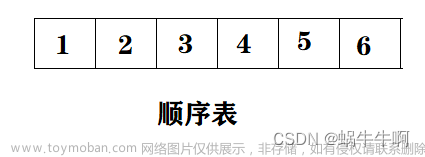
💐 🌸 🌷 🍀 🌹 🌻 🌺 🍁 🍃 🍂 🌿 🍄🍝 🍛 🍤
📃个人主页 :阿然成长日记 👈点击可跳转
📆 个人专栏: 🔹数据结构与算法🔹C语言进阶
🚩 不能则学,不知则问,耻于问人,决无长进
🍭 🍯 🍎 🍏 🍊 🍋 🍒 🍇 🍉 🍓 🍑 🍈 🍌 🍐 🍍
前言
我在上一篇博客中,详细讲解啦每一个函数的实现思路和代码展现,在这一篇博客中,我将像是做项目一样,去实现顺序表的总体实现。
一、项目源文件构成
该项目由三部分组成
1️⃣ 用来存放库函数,宏定义,函数申明等的一个头文件:SqList.h
2️⃣ 主函数的所在文件 test.c
3️⃣各个函数的实现,我们主要在此完成函数的代码编写:SqList.c
二、菜单
建立一个菜单是很重要的,菜单能够实现和用户的交互,以便于用户的操作。
代码如下:
void meun()
{
printf("**************************************************\n");
printf("* 1.顺序表尾插 2.顺序表尾删 *\n");
printf("* 3.顺序表头插 4.顺序表头删 *\n");
printf("* 5.顺序表的查找 6.在pos位置插入x *\n");
printf("* 7.删除pos位置的值 8.顺序表的打印 *\n");
printf("* 0.退出 *\n");
printf("**************************************************\n");
}
三、顺序表结构体
typedef int SLDataType;
typedef struct SeqList
{
SLDataType* array;
int size;//当前存储个数
int capacity;//空间大小
}SL;
四、源文件展示
下面是整个项目的代码:
1.SqList.h
#define _CRT_SECURE_NO_WARNINGS 1
#include<stdio.h>
#include<assert.h>
#include<stdlib.h>
#define INT_SIZE 2
typedef int SLDataType;
typedef struct SeqList
{
SLDataType* array;
int size;//当前存储个数
int capacity;//空间大小
}SL;
//顺序表的初始化
void SeqListInit(SL* ps);
// 顺序表尾插
void SeqListPushBack(SL* ps, SLDataType x);
// 顺序表尾删
void SeqListPopBack(SL* ps);
// 顺序表头插
void SeqListPushFront(SL* p, SLDataType x);
// 顺序表头删
void SeqListPopFront(SL* p);
// 顺序表查找
int SeqListFind(SL* p, SLDataType x);
// 顺序表在pos位置插入x
void SeqListInsert(SL* p, size_t pos, SLDataType x);
// 顺序表删除pos位置的值
void SeqListErase(SL* p, size_t pos);
// 顺序表销毁
void SeqListDestory(SL* p);
// 顺序表打印
void SeqListPrint(SL* p);
2.SqList.c
#define _CRT_SECURE_NO_WARNINGS 1
#include"SqList.h"
//顺序表的初始化
void SeqListInit(SL* ps)
{
ps->array = (SLDataType*)malloc(sizeof(SLDataType)*4);
if (ps->array == NULL)
{
perror("malloc failed\n");
exit(-1);
}
ps->size = 0;
ps->capacity = 4;
}
// 检查空间,如果满了,进行增容
int CheckCapacity(SL* ps)
{
if (ps->size == ps->capacity)
{
SLDataType* tmp = (SLDataType*)realloc(ps->array, (ps->capacity + INT_SIZE)*sizeof(SLDataType));
if (tmp == NULL)
{
perror("扩容失败!\n");
return 0;
}
else
{
ps->array = tmp;
ps->capacity += INT_SIZE;
printf("扩容成功\n");
return 1;
}
}
return 1;
}
// 顺序表销毁
void SeqListDestory(SL* ps)
{
free(ps->array);
ps->array = NULL;
ps->capacity = 0;
ps->size = 0;
}
// 顺序表尾插
void SeqListPushBack(SL* ps, SLDataType x)
{
if (CheckCapacity(ps) == 0)
{
printf("空间已满,插入失败!\n");
}
if (CheckCapacity(ps) == 1)
{
ps->array[ps->size] = x;
ps->size ++;
}
}
// 顺序表尾删
void SeqListPopBack(SL* ps)
{
if (ps->size < 1)
{
printf("已经为空,无元素可删除\n");
return;
}
ps->array[ps->size - 1] = 0;
ps->size--;
}
// 顺序表头插
void SeqListPushFront(SL* ps, SLDataType x)
{
//判断空间是否够。
//先挪动
if (CheckCapacity(ps) == 0)
{
printf("空间已满,头插入失败!\n");
}
if (CheckCapacity(ps) == 1)
{
int end = ps->size - 1;
while (end>=0)
{
ps->array[end + 1] = ps->array[end];
end--;
}
ps->array[0] = x;
ps->size++;
}
}
// 顺序表头删
void SeqListPopFront(SL* ps)
{
int n = 1;
while (n < ps->size)
{
ps->array[n - 1] = ps->array[n];
n++;
}
ps->size--;
}
// 顺序表打印
void SeqListPrint(SL* ps)
{
for (int i = 0; i < ps->size; i++)
{
printf("%d ", ps->array[i]);
}
printf("\n");
}
// 顺序表查找
int SeqListFind(SL* ps, SLDataType x)
{
int i = 0,count=0;
for (i = 0; i < ps->size - 1; i++)
{
if (x == ps->array[i])
{
printf("找到啦!下标是%d\n",i);
count++;
return i;
}
}
if (count == 0)
{
printf("没找到!\n");
return;
}
}
// 顺序表在pos位置插入x
void SeqListInsert(SL* ps, size_t pos, SLDataType x)
{
assert(pos>=0&&pos<ps->size);
if (CheckCapacity(ps) == 0)
{
printf("空间已满,插入失败!\n");
}
if (CheckCapacity(ps) == 1)
{
int end = ps->size - 1 ;
while (end >= pos)
{
ps->array[end + 1] = ps->array[end];
end--;
}
ps->array[pos] = x;
ps->size++;
}
}
// 顺序表删除pos位置的值
void SeqListErase(SL* ps, size_t pos)
{
assert(pos >= 0 && pos < ps->size);
int n = pos + 1;
while (n <= ps->size - 1)
{
ps->array[n - 1] = ps->array[n];
n++;
}
ps->size--;
}
3.test.c
#define _CRT_SECURE_NO_WARNINGS 1
#include"SqList.h"
void meun()
{
printf("**************************************************\n");
printf("* 1.顺序表尾插 2.顺序表尾删 *\n");
printf("* 3.顺序表头插 4.顺序表头删 *\n");
printf("* 5.顺序表的查找 6.在pos位置插入x *\n");
printf("* 7.删除pos位置的值 8.顺序表的打印 *\n");
printf("* 0.退出 *\n");
printf("**************************************************\n");
}
int main()
{
int x,pos;
SL s;
//初始化
SeqListInit(&s);
int input = 0;
do
{
meun();
printf("请输入你的选择:\n");
scanf("%d", &input);
switch (input)
{
case 1:
printf("请输入要尾插的值:");
scanf("%d", &x);
SeqListPushBack(&s, x);
break;
case 2:
SeqListPopBack(&s);
break;
case 3:
printf("请输入要头插的值:");
scanf("%d", &x);
SeqListPushFront(&s,x);
break;
case 4:SeqListPopFront(&s);
break;
case 5:
printf("请输入要查找的值:");
scanf("%d", &x);
SeqListFind(&s,x);
break;
case 6:
{
printf("请输入要插入的位置和数据(空格分开):");
scanf("%d %d", &pos,&x);
SeqListInsert(&s, pos, x);
break;
}
case 7:
printf("请输入要删除的位置:");
scanf("%d", &pos);
SeqListErase(&s,pos);
break;
case 8:
SeqListPrint(&s);
break;
case 0:
SeqListDestory(&s);
break;
default:printf("输入有误,请重新输入:\n");
}
}while (input);
}
五、运行截图
1.顺序表尾插,头插展示

2.顺序表的头删

3.顺序表的尾删

4.顺序表的查找

5.在pos位置插入x

6.在pos位置删除元素
 文章来源:https://www.toymoban.com/news/detail-614541.html
文章来源:https://www.toymoban.com/news/detail-614541.html
总结:
本次项目当中遇到许多之气没有注意到的问题,尤其是数组越界问题等等,在接下来学习数据结构预算法是非常重要的,🌈相信自己,踏踏实实走好每一步,梦想终会成为现实! ⛵️文章来源地址https://www.toymoban.com/news/detail-614541.html
到了这里,关于【C语言数据结构】模拟·顺序表·总项目实现的文章就介绍完了。如果您还想了解更多内容,请在右上角搜索TOY模板网以前的文章或继续浏览下面的相关文章,希望大家以后多多支持TOY模板网!













